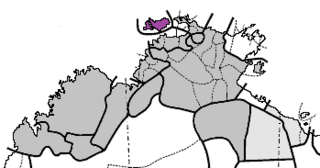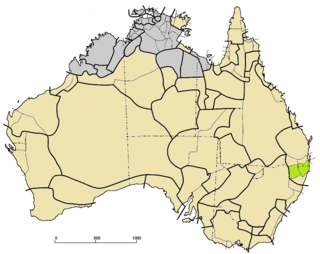Awabakal is an Australian Aboriginal language that was spoken around Lake Macquarie and Newcastle in New South Wales. The name is derived from Awaba, which was the native name of the lake. It was spoken by Awabakal and Wonnarua peoples.
Nhanda, also rendered Nhanta and Nhandi is an Australian Aboriginal language from the Midwest region of Western Australia, between Geraldton and the Murchison River, from the coast to about 20 kilometres (12 mi) inland. The language is now spoken, or semi-spoken, by only a few people.

Tiwi is an Australian Aboriginal language spoken by the Tiwi people on the Tiwi Islands, within sight of the coast of northern Australia. It is one of about 10% of Australian languages still being learned by children.
Iwaidja, in phonemic spelling Iwaja, is an Australian aboriginal language of the Iwaidja people with about 150 speakers in northernmost Australia. Historically from the base of the Cobourg Peninsula, it is now spoken on Croker Island. It is still being learnt by children.
Kuku-Thaypan is an extinct Paman language spoken on the southwestern part of the Cape York Peninsula, Queensland in Australia, by the Kuku-Thaypan people. The language was sometimes called Alaya or Awu Alaya. Koko-Rarmul may have been a dialect, though Bowern (2012) lists Gugu-Rarmul and Kuku-Thaypan as separate languages. The last native speaker, Tommy George, died 29 July 2016 in Cooktown Hospital.
Bardi is an endangered Australian Aboriginal language in the Nyulnyulan family. It is spoken in Northwestern Australia, on the Dampier peninsula and neighboring islands. Fewer than 10 speakers of Bardi remain alive today. Before European settlement at the end of the nineteenth century, the population size is estimated to have been ~1500 people, with essentially the entire community speaking Bardi. Since then, the ethnic population has increased in number, but is essentially monolingual in English today. That said, many middle-aged people can still understand the language, and some of them can speak it to a limited degree.

Yugambeh–Bundjalung, also known as Bandjalangic is a branch of the Pama–Nyungan language family, that is spoken in northeastern New South Wales and South-East Queensland.

Wunambal, or Northern Worrorran, is a moribund Australian Aboriginal language of Western Australia. It is a language that is often grouped alongside Worrorran and Ungarinyin, as they are from the same Northern Kimberley Division. Other names include Jeidji, Jeithi, Unambal, Wumnabal, Wunambullu, Yeidji, Yeithi.
Murrinh-patha, called Garama by the Jaminjung, is an Australian Aboriginal language spoken by over 2,500 people, most of whom live in Wadeye in the Northern Territory, where it is the dominant language of the community. It is spoken by the Murrinh-Patha people, as well as several other peoples whose languages are extinct or nearly so, including the Mati Ke and Marri-Djabin.

Angurugu is a community located on Groote Eylandt in the Northern Territory, Australia, just off the mainland. The main languages spoken there are Anindilyakwa, an Australian Aboriginal language, and English. A permit is required before travelling to Angurugu.

East Cree, also known as (Eastern) James Bay Cree, and East Main Cree, is a group of Cree dialects spoken in Quebec, Canada on the east coast of lower Hudson Bay and James Bay, and inland southeastward from James Bay. Cree is be one of the most spoken non-official aboriginal languages of Canada. Four dialects have been tentatively identified including the Southern Inland dialect (Iyiniw-Ayamiwin) spoken in Mistissini, Oujé-Bougoumou, Waswanipi, and Nemaska; the Southern Coastal dialect (Iyiyiw-Ayamiwin) spoken in Nemaska, Waskaganish, and Eastmain; the Northern Coastal Dialects (Iyiyiw-Ayimiwin), one spoken in Wemindji and Chisasibi and the other spoken in Whapmagoostui. The dialects are mutually intelligible, though difficulty arises as the distance between communities increases.
Rangi or Langi is a Bantu language of spoken by the Rangi people of Kondoa District in the Dodoma Region of Central Tanzania. Whilst the language is known as Rangi in English and Kirangi in the dominant Swahili spoken throughout the African Great Lakes, the self-referent term is Kilaangi.
Marra is an Australian Aboriginal language, traditionally spoken on an area of the Gulf of Carpentaria coast in the Northern Territory around the Roper, Towns and Limmen Bight Rivers. Marra is now an endangered language. The most recent survey was in 1991; at that time, there were only 15 speakers, all elderly. Most Marra people now speak Kriol as their main language. The remaining elderly Marra speakers live in the Aboriginal communities of Ngukurr, Numbulwar, Borroloola and Minyerri.
Burarra is an Australian Aboriginal language spoken by the Burarra people of Arnhem Land. It has several dialects.
Warndarang is an extinct Aboriginal Australian language in the Arnhem family, formerly spoken by the Warndarang people in southern Arnhem Land, along the Gulf of Carpentaria. The last speaker was Isaac Joshua, who died in 1974, while working with the linguist Jeffrey Heath.
Teiwa is a non-Austronesian, Papuan language spoken on the Pantar island in eastern Indonesia. The island is the second largest in the Alor archipelago, lying just west of the largest island Alor.

Alyangula is a township on Groote Eylandt in the Northern Territory.








